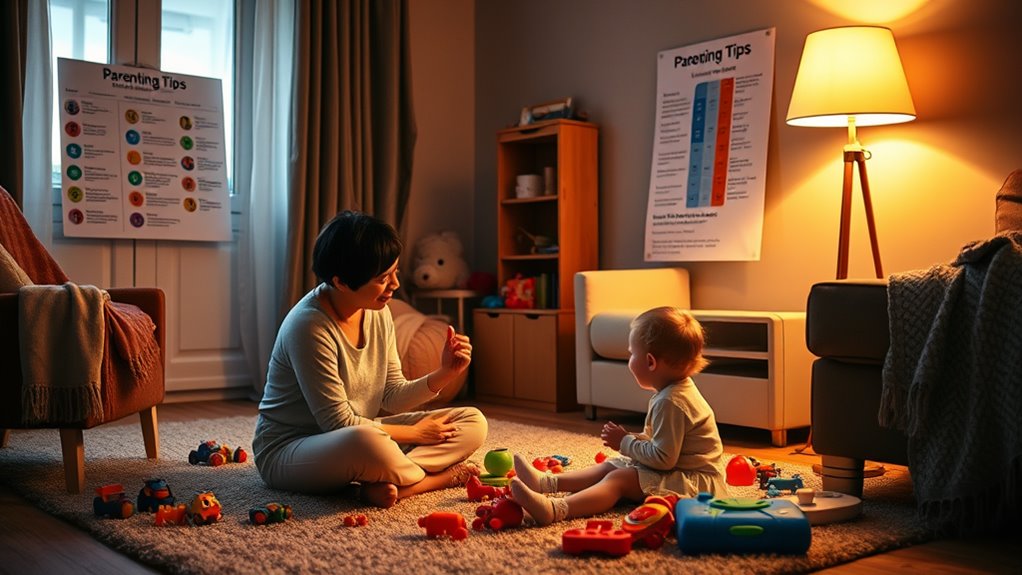How to Address Tantrums Effectively Without Yelling
To address tantrums effectively without yelling, start by understanding what triggers your child’s outbursts. Stay calm during the episode; use deep breathing to collect yourself. It’s important to acknowledge their feelings with phrases like, “I see you’re frustrated.” Encourage open communication by asking open-ended questions about their emotions. Modeling appropriate emotional responses helps them learn to express feelings constructively. Create a supportive environment with a calm atmosphere and consistent routines. Your approach can make a big difference in managing their behavior. There’s plenty more to explore on techniques that can help you navigate these challenging moments effectively.
Key Takeaways
- Practice Mindful Breathing: Use deep breathing techniques to maintain calmness during a tantrum, modeling emotional regulation for your child.
- Validate Emotions: Acknowledge your child’s feelings with phrases like, “I see you’re upset,” to help them feel understood without escalating the situation.
- Use Positive Reinforcement: Praise your child when they attempt to calm down, reinforcing the behavior you want to see more of in the future.
- Create a Safe Space: Designate a calming area with comforting items where your child can retreat when feeling overwhelmed to manage their emotions.
- Encourage Open Communication: Ask open-ended questions to help your child articulate their feelings, fostering better understanding and reducing the likelihood of tantrums.
Understanding Tantrum Triggers
Understanding what triggers tantrums is essential for effectively managing them. Recognizing both environmental factors and emotional states helps you pinpoint what might lead to an outburst.
For instance, if you notice that your child tends to throw tantrums in crowded or noisy places, that environmental factor could be overwhelming them. Identifying these triggers allows you to prepare or avoid those situations when possible.
Similarly, emotional states play a crucial role. Children often can’t express their feelings verbally, leading to frustration. If they’re tired, hungry, or feeling unwell, those emotional states can escalate into a tantrum.
Pay attention to patterns; when you see certain emotions surfacing, like anger or sadness, you’ll be better equipped to intervene before it turns into a full-blown outburst.
Staying Calm During Outbursts
When a tantrum erupts, staying calm can be one of the toughest challenges for a parent. Your instinct might be to react with frustration or anger, but remember, your child is looking to you for guidance.
Practicing mindful breathing can help you regain your composure. Take a deep breath in through your nose, hold it for a moment, and exhale slowly through your mouth. This simple technique can ground you, making it easier to respond thoughtfully instead of reacting impulsively.
As you maintain your calm, it’s essential to remember that your reaction sets the tone for the situation. Use positive reinforcement to encourage your child when they begin to settle down. Acknowledge their efforts to express their feelings in a more controlled manner, even if they’re still upset.
Phrases like, “I see you’re trying to calm down,” can validate their emotions and reinforce better behavior.
Staying calm during outbursts isn’t just about you; it teaches your child how to manage their emotions effectively. By modeling this behavior, you’re helping them learn the importance of self-regulation and emotional intelligence.
Effective Communication Techniques
Effective communication techniques can be a game changer during tantrums, as they help you connect with your child on a deeper level. One crucial method is active listening. This means focusing entirely on what your child is saying without interrupting. By giving them your full attention, you show that their feelings matter, which can defuse the situation.
Next, practice empathy development. When your child is upset, acknowledge their emotions by saying things like, “I understand you’re frustrated.” This simple phrase validates their feelings and encourages them to express themselves. It’s essential to avoid dismissing their emotions, as this can lead to more intense reactions.
You can also ask open-ended questions to help your child articulate their feelings. Try saying, “Can you tell me what’s bothering you?” This invites dialogue and reinforces that you’re there to listen.
Lastly, maintain a calm tone and body language. Your demeanor sets the stage for how your child responds. By mastering these effective communication techniques, you create a supportive environment that not only helps during tantrums but also fosters a stronger bond between you and your child.
Teaching Emotional Regulation
Teaching your child to manage their emotions can significantly reduce the frequency and intensity of tantrums. One effective way to do this is through modeling behavior. When you demonstrate healthy emotional responses in challenging situations, your child learns how to handle their feelings by watching you.
For example, if you face frustration, verbalize your feelings calmly instead of reacting impulsively. This teaches your child that it’s okay to feel upset but important to express those feelings constructively.
Additionally, help your child build their emotional vocabulary. Encourage them to label their feelings by using words like “angry,” “sad,” or “frustrated.” When they can articulate what they’re experiencing, they’re less likely to resort to tantrums. You might say, “I can see you’re feeling really upset right now. Let’s talk about it.”
Creating opportunities for discussions about emotions can also empower your child to recognize their feelings before they escalate.
Creating a Supportive Environment
A calm and inviting home can make a big difference in how your child handles emotions and tantrums. When you create a supportive environment, your child feels secure, which helps them express their feelings more constructively.
Start by designating a safe space in your home where your child can retreat when they feel overwhelmed. This area can include comforting items like pillows, blankets, or their favorite toys, making it a cozy refuge during tough moments.
Incorporating positive reinforcement is essential, too. Acknowledge and praise your child when they manage their emotions well, even in small ways. This encourages them to continue using healthy coping strategies. You might say, “I’m proud of you for taking a deep breath instead of yelling.”
Additionally, maintain a consistent routine to provide stability. When children know what to expect, they’re less likely to feel anxious or act out.
Ultimately, creating a supportive environment means being present and attentive to your child’s needs. By fostering a nurturing atmosphere, you’ll not only help reduce tantrums but also strengthen your bond with your child.
Frequently Asked Questions
What Are Common Misconceptions About Tantrums?
Tantrums aren’t just storms of chaos; they’re often signals of unmet needs. You might think they’re purely attention-seeking, but they often stem from triggering factors and a child’s struggle with emotional regulation.
How Can I Differentiate Tantrums From Other Behaviors?
To differentiate tantrums from other behaviors, focus on emotional triggers and behavior cues. Tantrums often arise from frustration or unmet needs, while other behaviors may signal boredom or attention-seeking. Observe the context to understand better.
When Should I Seek Professional Help for Tantrums?
You might wonder when to seek help for tantrums. Look for signs of trouble like intensity, frequency, or when they disrupt daily life. If you’re feeling overwhelmed, don’t hesitate to reach out for support.
Are Tantrums More Common in Certain Age Groups?
Yes, tantrums are more common in toddlers, as they struggle with emotions and communication. Preschool behaviors might also include tantrums, but they typically show more coping strategies as they develop social skills and language.
Can Diet Affect a Child’s Tendency to Have Tantrums?
Did you know that 30% of parents notice increased tantrums during dietary changes? You can explore nutrition strategies, as dietary influences like sugar and additives might contribute to your child’s emotional outbursts.





